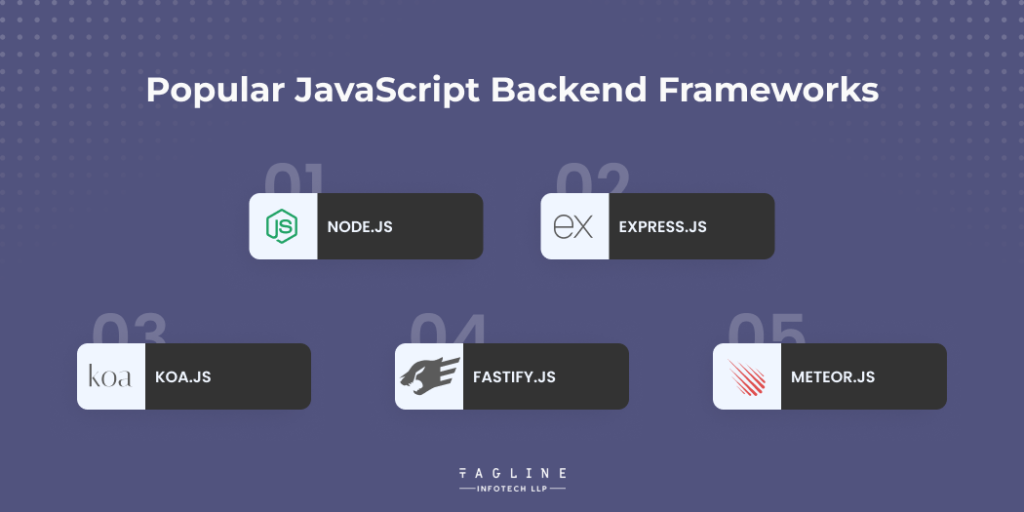A List of The 25 Best Ruby on...
May 8, 2024
Home >> JavaScript >> JavaScript Backend Development: A Simple Introduction

Quick Summary
JavaScript is a computer language that allows users to accomplish many things, such as handling multimedia, animating graphics, and creating dynamically updated content. It was once referred to as a client-side language, and its primary purpose was to improve the visual appeal of websites by giving them a more dynamic and immersive appearance. Despite this, it is a universal language with many applications in modern JavaScript Backend Development. Development experts use JavaScript for server-side programming to design web apps more easily. This is done by employing JavaScript libraries and frameworks.
The part of web development on the server side, where the developer writes the code that powers the web application, is called backend development. The front end is the area of a website that a user views and interacts with when they are on the internet. The backend powers the front end; when it’s running, it often runs on a web server.
The backend is responsible for all of the following:
The back end is commonly referred to as the “server side.” Also known as “client-side” programming, “front end” refers to what occurs inside the browser. Anything that end users view and engage with is included in this. The server and databases make up the back end, which differs from the front end in that they can be found locally or in the cloud. Put another way, all of the equipment operating in the background that the user cannot view or directly interact with is what is causing the problems.
This handy way of breaking up programming has changed significantly over the past ten to fifteen years due to the rapid growth of JavaScript, which was less widespread on the front end than it is now or as common on the back end because of Node.js. It is important to emphasize that this method has experienced significant alterations because of this. The two are more similar than different, especially regarding the role a JavaScript developer might play on a stack that runs just on JavaScript.
The rear JavaScript is the programming language developers use to write server-side code. This code is in charge of an application’s server-side logic, which includes communication with external databases.
JavaScript code can be executed independently of a web browser thanks to Node.js, a JavaScript runtime environment. When it was first released in 2009, it aimed to make server-side JavaScript applications run. The environment is based on the V8 JavaScript engine and is cross-platform. It includes many libraries and tools intended to help developers create applications with tremendous capability.
Programming can be done asynchronously, where the program moves on to the next task without waiting for the previous one to finish. This eliminates the requirement for the server to wait for one request to complete before processing another and allows the server to handle multiple requests simultaneously. It is, therefore, the perfect option for backend development.
Requirements for backend development include speed. The browser does not need to download and understand JavaScript because it is built and executed on the server.
“TypeScript vs JavaScript: Understanding the Key Distinctions “
– Also Read Article

Whenever a client requests the client side of the application, it is first sent to the server. The server then processes or calculates something to ensure the original request is genuine. Finally, a response is sent to the system’s client side. The Node.js framework is the recommended choice for these kinds of computations and processing.
Among the many kinds of apps that may be created using Node.js are Internet of Things (I/O)-intensive apps like online chat services and websites that stream videos. Both newly established start-ups and numerous well-known tech giants rely on the Node.js framework for their operations.
Express.js is a lightweight and adaptable Node.js framework for Internet applications. It offers an extensive feature set that can be applied to mobile and web applications.
A summary of some of the traits is provided below:
The Koa web framework is constructed using Node.js. Due to its lightweight architecture and small collection of fundamental functions, it is perfect for creating web applications and application programming interfaces (APIs).
One thing that sets it apart from many other web frameworks is that it doesn’t include any middleware. This gives you even more flexibility because you may select the middleware that best fits your needs. Furthermore, it leaves a less noticeable effect.
If you are familiar with Express, you will see that Koa has a structure and philosophy similar to those of Express. The two frameworks are frequently compared.
A web framework called Fastify was created using Node.js. This application is inspired by Hapi and Express and is made to be quick and easy to use. It employs a schema-based methodology that lets you specify input and output schemas together with your routes. Before sending it to your handlers, you can verify your data using this method. It is also extensible so that you can create custom plugins with it.
The Node.js framework is the foundation for MeteorJS, an open-source JavaScript web framework. It generates code compatible with several platforms (Android, iOS, and web), enabling rapid prototyping. Its capabilities include MongoDB and the Distributed Data Protocol. It also uses a publish-subscribe architecture to automatically transmit data updates to clients, saving the developer from having to write any synchronization code in the process.
Curious about the limitless possibilities of JavaScript in Backend Development?
Connect with our team to unravel the potential of server-side scripting, master frameworks, and build scalable applications.
Depending on the developer’s goals, using JavaScript as a backend language has various benefits and drawbacks. Consider a few crucial factors before deciding to use JavaScript for your back end.
Utilizing JavaScript as a backend programming language has benefits and drawbacks.
Using JavaScript as a backend language has many benefits and disadvantages, and they depend on the developer’s goals. Consider a few crucial factors before deciding to use JavaScript for your back end.
Cons:
All credits go to runtime frameworks for JavaScript like Node.js; JavaScript may offer a back end for web applications or function as a server-side for other kinds of applications. As a result, JavaScript is now present on the back end of many applications, including webpages and mobile applications. However, web applications are the most typical contexts in which JavaScript is used on the back end. Because it allows developers to blur the boundaries between frontend and backend systems, this gives them a great degree of flexibility.
Due to its immense popularity, developers are strongly encouraged to include JavaScript in their apps on both the front and back ends. Many developers have worked with JavaScript before, and their ability to swiftly spin up code for the client and server allows them to create robust applications. Developers no longer need to integrate many technologies to accomplish basic operations, such as synchronizing an interface with the back end simultaneously.
There are better backend languages than JavaScript for scenarios requiring a high CPU consumption. Because JavaScript is a single-threaded programming language, script processing is linear. As a result, JavaScript cannot fully use CPU multithreading and other speed improvements. More control and the capacity to fine-tune performance-sensitive backend applications can be obtained using earlier standards, such as C++. This is especially helpful for programs that put a lot of strain on the server’s central processing unit (CPU).
Discover if JavaScript is the right tool for your project with Tagline Infotech, a leading Software Development Company. Whether JavaScript is the right tool for the job will ultimately depend on each project’s particular requirements. However, JavaScript and alternative runtimes like Node.js are gaining popularity among developers and designers. JavaScript offers a straightforward method for creating capable interfaces with strong back ends. It is easy to design, works well in most situations, and is simple to implement.

Digital Valley, 423, Apple Square, beside Lajamni Chowk, Mota Varachha, Surat, Gujarat 394101
+91 9913 808 2851133 Sampley Ln Leander, Texas, 78641
52 Godalming Avenue, wallington, London - SM6 8NW